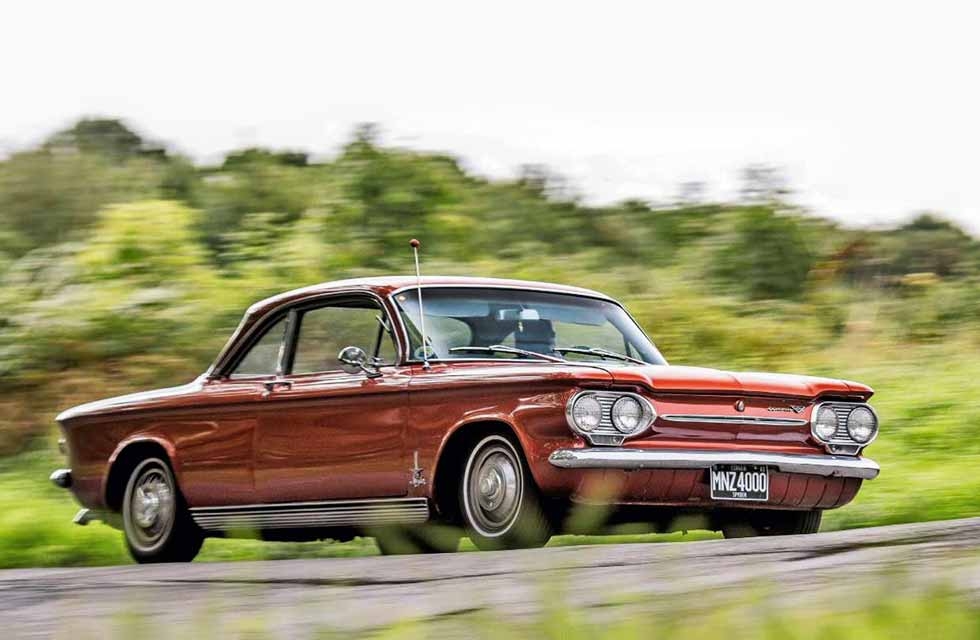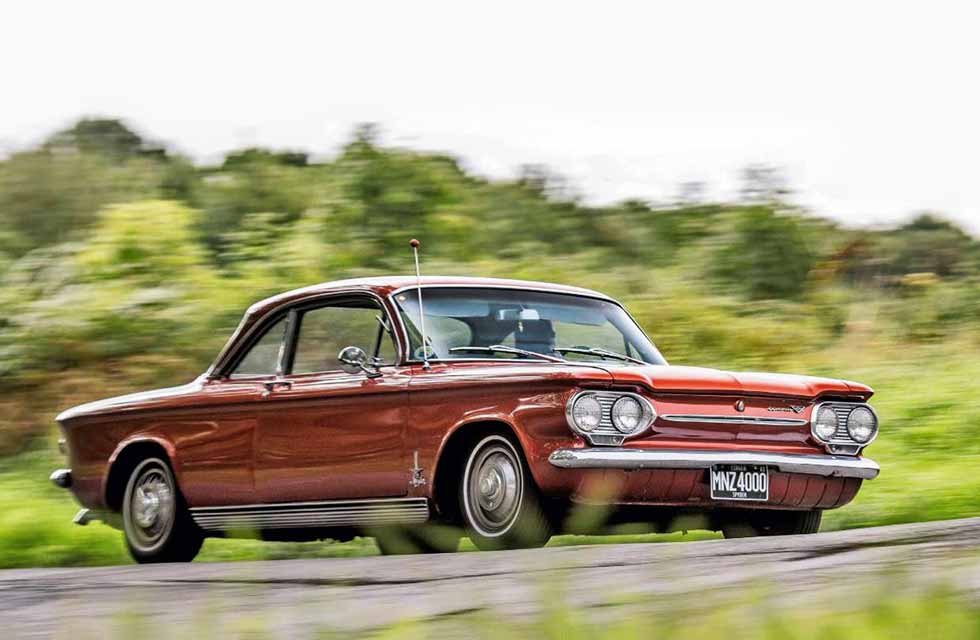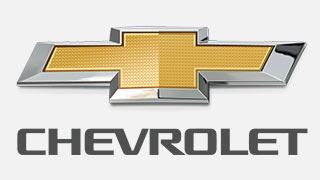
Air Force – the 1963 Chevrolet Corvair Monza Spyder was the first turbo car. Is it lethal? The Chevrolet Corvair may have been a market failure, but its range contained a real groundbreaker. We drive the Monza Spyder, to see if it really deserved its wayward reputation. Words Sam Dawson. Photography Jonathan Jacob.
AIR FORCE
Braving a Chevy Corvair Monza turbo
See if you can guess the car from the description. Rear-mounted, aircooled flat-six. Turbocharged. Semi-trailing-arm rear suspension. Limitedslip differential. Monocoque steel bodyshell. Infamous widowmaker reputation because of tail-happiness in the wrong circumstances.

Initially available only as a hardtop coupé on account of concerns about such urgent power combined with a physically compromised structure. Developed into a racing car by an engineer who’d cut his teeth racing with Germany’s top World Sports Car Championship team. Conceptual origins in the Porsche 356. You’re thinking 911 Turbo aren’t you? And yet the Chevrolet Corvair Monza Spyder doesn’t just predate Porsche’s supercar, but the 911 line entirely, dating from 1962. And of course it’s American, hailing from an automotive industry which, cliché suggests, was all about luxury, convenience and V8s in the early Sixties.
‘It may be flawed, but it was only ever mere details away from being a genuine rival to the Porsche 911’
The Corvair? Far from being some technical Porsche-predicting groundbreaker, wasn’t that the car that represented all that was bad about the American car industry, prompting safety campaigning politician Ralph Nader to write Unsafe At Any Speed? Well, yes it was, but there was nothing fundamentally wrong with the Corvair’s design. Rather, its early iterations were just as much a victim of the way the American car industry thought at the time as any unfortunate customers who managed to unintentionally find themselves flailing at the wheel attempting to control its wild oversteer discovered. The car itself, and its pioneering design engineer Ed Cole, were haplessly innocent parties.
Approaching this, the only running example of a Chevrolet Corvair Monza Spyder in the UK, I’m struck by how strangely rootless the design is. Its dimensions aren’t particularly transatlantic – size-wise it’s roughly the same as a contemporary Ford Zephyr – and there are no rocket-fins or muscle-car haunches to scream power or status. Only a few tiny badges tell bystanders it’s turbocharged. There’s a tiny hint of Cadillac in its twin chrome-backed headlamps and jutting brow, but with no front air intake it looks more like a gigantic Renault 8, Hillman Imp or NSU Prinz 4.
Then bear in mind that those crisp examples of Sixties modernity all copied Chevrolet. Only the boomerang-shaped chrome A-pillar dates its origins to an American drawing office in 1959. If someone told me Giovanni Michelotti had designed it in Turin in the Sixties, I’d have believed them.
Before I climb aboard, I take a look at the tail. There’s a strong hint of Corvette to it in its boat-tailed profile and rows of circular taillights. But those long rows of engine-cooling louvres along the rear deck are pure European sports car. The driving position is very familiar to Europeans too. Pedals are offset towards the centre, and the big steering wheel sits upright and close to my chest. Just like, well, a Porsche. Even the instrument binnacle looks like it came out of Zuffenhausen rather than Detroit.
It’s also reminiscent of a 911 on the turn of the ignition key. First, the starter motor whizzing into life somewhere behind me, then the lusty, windy, thumping chatter of six horizontally-opposed, air-cooled cylinders sparking into life. To an American customer weaned on loping front-mounted straight-sixes in cars of this size and price, this would have been an unusual experience. Offputtingly alien, perhaps – after all, a dummy grille was available as an official Chevrolet accessory for Corvair buyers who wanted their car to look more familiar.
Or perhaps not. We like to characterise American cars and their buyers in the Fifties and Sixties as a stiflingly conservative bunch, sticking with things like live rear axles, conventional engine designs and gearboxes with a surprisingly small number of ratios in them. And yet, this was the era of NASA’s Apollo programme, the GM Motoramas, and the cultural gift of science-fiction blazing a trail across television screens, childrens’ comic books and novels read by intellectuals alike. This was the nation that had just broken the sound barrier. Americans had a hunger for tangible signs of this sense of breakneck progress, and perhaps not just limited to a fridge that looked a bit like an electric express train.
The turbocharger that hides transversely behind the rear seats in the Corvair Monza Spyder, taking up the space usually reserved for the air-conditioning unit meaning none could be fitted with this luxury, was the joint-first example of this kind of forced-induction being available on a production car. Engine-driven superchargers were as old as the industry. But harnessing the energy of the gases expelled by the engine to increase compression was aircraft technology, originally aimed at increasing air density in a piston-driven aero engine’s intakes at high altitude.
‘It was a victim of the way the American car industry thought at the time’
Ironically, the jet age was actually making turbocharging technology mundane by the time General Motors decided to install it in a couple of their cars in 1962 to boost power and torque in its smaller engines. Not that it stopped Oldsmobile calling the other one the preposterously cool-sounding F-85 Jetfire. While that car was otherwise conventionally American, with its Buick 3.5-litre V8 up front driving the rear wheels of a car derived from the Cutlass, the Corvair Monza Spyder wore its European influences overtly, from its near-total lack of Chevrolet badges to a name which spoke of Italian supercars.
Pulling away onto the rural lanes of South Yorkshire, the odd-looking yet precise-feeling curved gear lever slotted home, it still sounds very much like a Porsche 911, although the drum brakes aren’t completely confidence-inspiring in modern disc-braked traffic. They’d be considered good for their era, although they’re a reminder of one aspect of American engineering holding the Spyder back from true comparisons with European sports cars.
But the real surprise comes as the traffic clears. This may be the first example of a turbocharged car available, and yet as I reach 2750rpm and the flat-six chunter is joined by a distant gale-like howl from behind the rear seats, I realise that it doesn’t actually suffer from turbo-lag. It’s probably because it’s a relatively low-pressure turbocharger more akin to the light-pressure units used by Saab and Volvo in the late Eighties, and doesn’t actually help the engine liberate much by way of power – 150bhp – compared to more performance-focused turbo-cars.
Instead of a sporty 911 jiggle, it immediately acquits itself as a superb highway cruiser. It rides beautifully, gliding along serenely, the turbo-torque meaning revolutions can be kept low, the car sounding like a distant Cessna from the outside. The way the Monza Spyder was presented may have drawn on the imagery of the Autodromo and stripped-out fly-screened sports-racers, but it was built for the era of soaring freeways. And if there was something which kept Americans buying domestic products rather than small-engined imports from Europe and Japan in the Sixties, despite the fuel economy gains on offer, it was the ability to cruise these asphalt airways at high speed with the engine gently turning over. A ground-bound personal jet in the form of a highway cruiser was the true mass-consumed product that really defined the jet age. The number of people who could actually afford to travel on an airliner was relatively small, but highways brought the effortless interstate dream much closer.
With this highway-orientated character also comes an unexpected sense of stability at the rear, especially under acceleration. The Corvair was much-criticised when new, on account of trailing-arm suspension that seemed poorly-located, making the car hard to control if the rear tyres broke traction. This might have surprised its creator, Ed Cole, because he’d derived the design from – and tested the Corvair’s engines in – a Porsche 356. However, just before its launch, GM’s bean-counters decided the suspension was too complex, and simplified it as part of a rationalisation process, removing its anti-roll bars, saving a grand total of $7 per car. As part of its sportier makeover, the Monza Spyder reinstated them, as well as stiffer springs and dampers, ahead of their standardisation across the range in 1964.
However, by this point the damage was done. Ralph Nader had already investigated GM’s handling of the Corvair’s suspension design in the first chapter of his 1965-released Unsafe At Any Speed: The Designed-In Dangers of The American Automobile. The whole industry came in for criticism in the book for prioritising costcutting over driver and pedestrian safety, but the prominence of the Corvair within it caused customers to avoid the car in particular.
‘The big wheel leaves you having to flail at it, dragging the car round corners’
This all weighs heavily in my mind as I pitch the Corvair into a downward-winding hillside bend. The single-circuit brake system needs pumping ahead of hard deceleration, making the process fraught enough, and although the gear lever is slick and linear in its motion it’s fairly long-travel and can’t be rushed. However, all these criticisms could be levelled at old Porsches too. What really undermines the Corvair’s sporty credentials is actually its steering. At four and a half turns lock-to-lock, it’s just too slow to handle sudden camber-changes or react to a fast, twisty road. The recirculating-ball setup is also vague, and the big wheel leaves you having to flail at it, dragging the car round corners rather than assuredly guiding it as you would with a Porsche.
Chevrolet made a virtue of the Corvair’s budget-priced simplicity when new, pointing out that it didn’t need power steering on account of the lack of weight over the nose, while clearly giving it a large wheel and low-geared steering to lessen the effort needed to turn it. I’m gripping the wheel hard to keep me in place too – amazingly these flat-bottomed seats with precious little lateral support were the ‘sports’ option – standard Corvairs got a slippery full-width bench seat.
And yet, two serious racers saw Porsche-like potential in the Monza. Original Corvair test driver John Fitch – who approved the car before GM deleted its anti-roll bars – decided to offer a set of officially approved tuning and modification options that could be combined in a car known as the Sprint. Fitch had been part of the all-conquering Mercedes-Benz racing team of the Fifties, campaigning the SL at Le Mans and winning his class at the Mille Miglia. As well as straightforward tuning, much of Fitch’s attention was focused on giving the car a greater sense of European-style controllability and stability, and involved creating his own brake shoes, and quickening the steering ratio. Most dramatically, a glassfibre fastback roof intended to increase rear aerodynamic downforce could be attached to the car, any join lines disguised with a vinyl roof. The options remained in production throughout the Corvair’s life until its demise in 1969.
Don Yenko’s performance workshop took things even further. Starting with the quad-Rochester-H-carburettor, 180bhp ‘Corsa’ upgrade, he homologated 100 cars for the SCCA’s Class D sports car racing category by removing the rear seats, replacing the steel engine covers with lightweight, bewinged glassfibre lookalikes, and following Fitch’s lead endowed them with faster steering boxes. The engine was overhauled with Moraine conrods and bearings, high-lift camshaft, reshaped forged pistons and an increased compression ratio to give 220bhp. The Yenko Stingers put up a strong showing against British opposition in 1966, but before it could carve out a reputation for itself as a car for the sort of people who owned driving gloves, the Corsa option was dropped as Corvair sales continued to flag in the wake of the Nader revelations.
And it’s this aspect of it that makes driving the only Corvair Monza Spyder in the country such a bittersweet experience. It may be a flawed car, even given Chevrolet’s own revisions, but as Fitch and Yenko demonstrated, it was only ever mere details away from being a genuine rival to the Porsche 911, yet with the reassurance of mass production behind it, and as the howling Carter YH ‘Turbo-carburetor’ in the rear demonstrates, hardly lagging behind in terms of technical innovation either.
GM may be notorious for counting the pennies, and would no doubt point out that the Corvette has always been on hand whenever Porsche comes spoiling for a fight. However, with its front-mounted V8 there’s something so predictable about it. The Monza Spyder is proof that once upon a time, Chevrolet could actually have beaten Porsche to market with a 911 rival capable of being built in vast numbers, sold for an affordable price, and proving its mettle on track against the best Europe could throw at it. Given that the Corvair would have been backed by the sales and marketing might of one of the world’s biggest manufacturers, would Porsche’s 911 even have been developed in the way it has, especially if the Corvair had survived its Nader ordeal and made it, Fitch-modified, to Europe, sold via the vast Vauxhall and Opel dealerships at a temptingly low price? It’s a fascinating thought to ponder.
Corvair Monza Spyder is at its most confident cruising freeways. In Corvair parlance, Spyder means turbo, not roadster. Afterburner-style taillights are one of the design’s few Americanisms. Corvair designer Ed Cole also worked on the Corvette C1. Tiny badge, yet it signifies a huge technical step forward: a turbo. Sporting potential, but long-winded steering lets the Corvair down. Unsupportive seats, but interior is more European than US in style.
OWNING A MONZA SPYDER
‘‘I found it for sale in Pennsylvania seven years ago,’ says the Corvair Monza Spyder’s owner, American car repair and restoration specialist Bill Smith. ‘It’s incredible how undervalued they still are for such a groundbreaking car – you can still find good Monza Spyders for less than $10,000 in the US.
They’re something of a cult car out there – so far as the mass market’s concerned they’ve never quite shaken off their reputation for being a bit of a lemon thanks to Nader’s book. But there are enthusiasts out there that appreciate them, who’ll restore them and ensure they’re worth something, and dry-state cars are often well-preserved.
I had to do a partial respray and address some rust here and there, but it’s been reliable, and all the mechanical parts are available. Refreshing the interior will be trickier though – the dashboard needs re-covering.
‘When you look at the specification of the car, and how futuristic it was, it’s clear it was the right car at the wrong time. People just weren’t ready for it. One of the main problems with it was tyre pressures – the correct ones for the car were 15psi front, 26psi rear. Back in the days of forecourt service, attendants used to inflate all the tyres they saw to 24psi regardless as part of their vehicle checks, accidentally biasing the grip towards the front and making the steering overly light and ineffective. Most accidents happened just after their owners had stopped for fuel.’
1963 Chevrolet Corvair Monza Spyder
Engine 2683cc horizontally-opposed six-cylinder, ohv, two Rochester H carburettors, Carter YH turbocharger
Max Power 150bhp @ 4400rpm
Max Torque 134lb ft @ 2800rpm
Transmission Four-speed manual, rear-wheel drive
Steering Recirculating ball
Suspension Front: independent, wishbones, coil springs, telescopic dampers, antiroll bar; Rear: independent, semi-trailing arms, coil springs, telescopic dampers
Brakes Drums front and rear
Weight 1134kg
Performance
Top speed: 103mph
0-60mph: 7.8sec
Cost new $2438
Approximate value now £10,000






